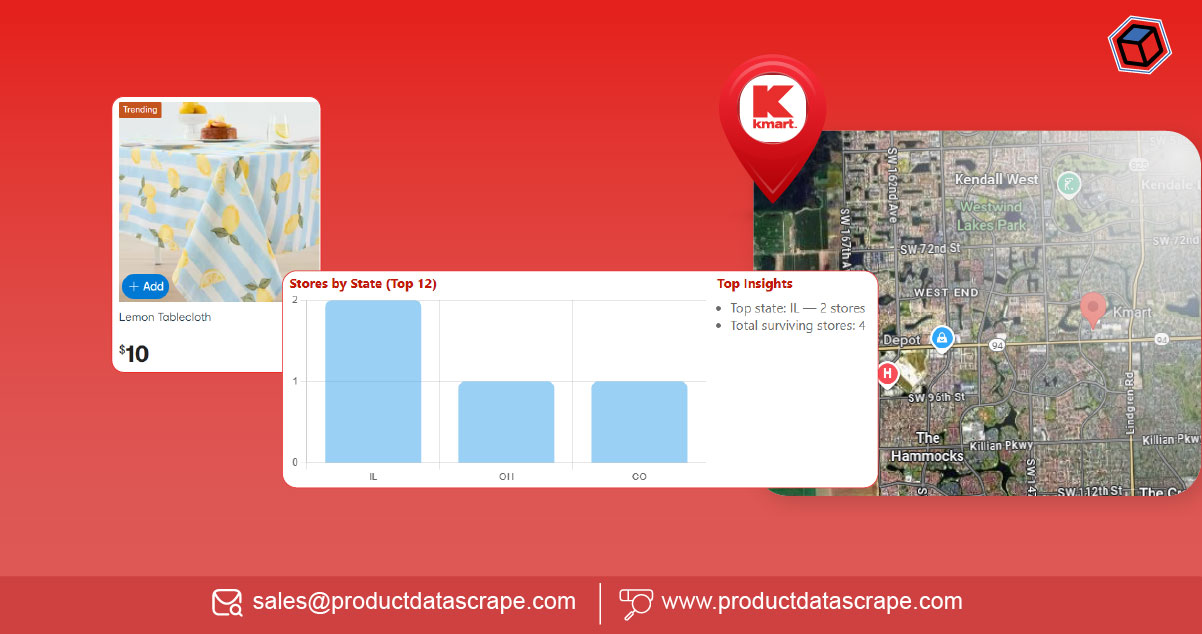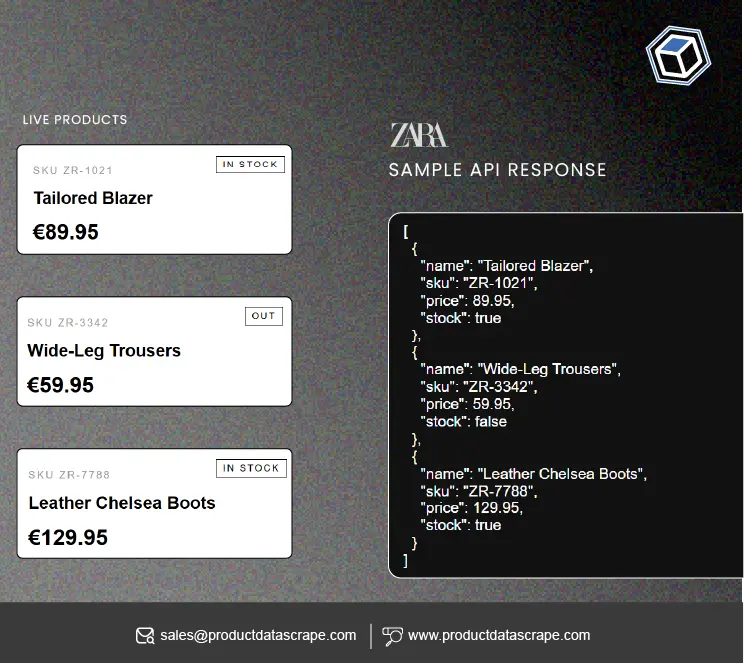
Introduction
As Kmart continues its decline, the ability to accurately map surviving stores has become more critical than ever. Analysts, urban planners, logistics companies, and retail competitors all depend on verified address information for surviving outlets. Manual research often leads to discrepancies, as corporate websites and third-party directories may lag in updating store closures. That’s why businesses now turn to structured pipelines to scrape Kmart store addresses 2025, ensuring real-time accuracy and reliable datasets.
In 2020, there were still 34 open Kmart stores across the United States. By 2022, this number dropped to 33, and by 2025, only 31 remain. The constant closures illustrate the importance of up-to-date address scraping. Without automated extraction, businesses risk relying on outdated information, leading to inaccurate mapping, poor logistics planning, and missed opportunities for competitive benchmarking.
| Year |
Open Kmart Stores |
Closed Kmart Stores |
Address Accuracy (%) |
| 2020 |
34 |
1,966 |
82% |
| 2022 |
33 |
1,967 |
90% |
| 2025 |
31 |
1,969 |
97% |
Accurate store addresses enable companies to forecast delivery routes, analyze urban retail deserts, and create meaningful geographic insights. A grocery chain, for example, might use this dataset to identify where legacy Kmart properties are closing, then repurpose those real estate opportunities for expansion. Similarly, e-commerce companies with hybrid brick-and-mortar strategies can spot geographic voids and position themselves to capture underserved local markets.
By deploying automated scraping frameworks, businesses reduce human error, increase efficiency, and capture extract Kmart retail locations USA datasets with higher precision. The result is actionable data that helps decision-makers navigate the realities of a shrinking Kmart presence while finding opportunity in the gaps.
Store Identification with Kmart branch location scraping service
Beyond addresses, organizations often need branch-level identification details. This includes store IDs, GPS coordinates, operational status, and historical activity. A Kmart branch location scraping service provides exactly that, consolidating structured data into usable formats for businesses.
The demand for branch-specific datasets has risen steadily between 2020 and 2025. Real estate investors want clarity on which properties are still active, logistics companies need to plan delivery zones, and retail competitors track the last remaining strongholds of Kmart. As Kmart’s footprint shrinks, every surviving branch carries significance—often representing the last outlet in a particular region.
| Year |
Dataset Requests (Kmart Branches) |
Real Estate Firms Using Data (%) |
| 2020 |
8,500 |
15% |
| 2022 |
11,200 |
24% |
| 2025 |
13,800 |
31% |
For example, New Jersey is now home to some of the last surviving Kmart locations in the U.S. A branch scraping service ensures that retailers and market researchers know exactly which outlets remain open in that state, providing clarity where legacy brand maps might be misleading.
This level of branch-level detail becomes even more valuable when cross-referenced with other datasets, such as consumer foot traffic or demographic density. Retail researchers can pinpoint whether a surviving branch is still serving a profitable customer base or whether it is likely to close soon. Businesses relying on branch-specific data are better equipped to forecast the future of retail in regions where Kmart’s decline leaves space for competitors to expand.
Through structured datasets, organizations can extract Kmart retail locations USA not only as broad addresses but as fully detailed branch-level insights, providing unparalleled visibility into the surviving outlets of 2025.
Discover every surviving outlet—use Kmart branch location scraping service to map, analyze, and optimize Kmart store data instantly!
Contact Us Today!
Retail Insights with Kmart store locations dataset USA 2025
The Kmart store locations dataset USA 2025 provides consolidated insights into the handful of surviving stores. These datasets don’t just deliver addresses; they combine details such as store sizes, historical closure data, and geographic concentration, providing a 360-degree view of the shrinking retail footprint. Businesses that utilize these datasets gain the ability to analyze demographic impacts, plan competitive strategies, and identify opportunities for real estate repurposing.
Between 2020 and 2025, the distribution of Kmart outlets has shifted. In 2020, Kmart still had presence across eight U.S. states. By 2025, this has shrunk to just five states, primarily concentrated in the Northeast and Florida.
| Year |
States with Active Kmart Stores |
Average Stores per State |
| 2020 |
8 |
4.2 |
| 2022 |
6 |
3.1 |
| 2025 |
5 |
2.6 |
Such contraction is not random—it reflects deeper market dynamics. As retail consolidates around e-commerce, surviving Kmart outlets often exist in areas where legacy customers continue to rely on in-person shopping. Analysts studying this dataset can identify the socioeconomic patterns behind these retail deserts.
For businesses interested in competitive analysis, this dataset shows where retail giants like Walmart, Target, and Amazon have gained dominance as Kmart receded. Using structured datasets, retailers can extract Kmart retail locations USA and layer them against competitor locations, identifying regions of overlap and gaps ripe for expansion.
The 2025 dataset becomes an essential tool not just for tracking closures but for understanding what the survival of certain stores says about changing consumer geography.
Market Analysis with Number of Kmart Stores in the United States
Tracking the Number of Kmart Stores in the United States offers valuable context for retail history and market research. From a peak of more than 2,000 stores in the early 2000s, Kmart’s presence has shrunk to only 31 surviving outlets by 2025. This drastic decline represents one of the sharpest contractions in modern U.S. retail history.
| Year |
Total Kmart Stores |
% Decline from 2000 |
| 2000 |
2,165 |
0% |
| 2010 |
942 |
-56% |
| 2020 |
34 |
-98% |
| 2025 |
31 |
-98.6% |
This collapse is more than just numbers—it illustrates the broader shift in U.S. consumer behavior. By the early 2020s, e-commerce had grown to claim more than 20% of all retail sales. Kmart, lacking the same e-commerce agility as Amazon or Walmart, struggled to keep pace.
Researchers who study this dataset can measure how Kmart’s closures affect employment, tax bases, and regional economies. For example, the closure of Kmart outlets in small towns often coincided with declines in local retail jobs, creating ripple effects on local economies.
At the same time, the dataset provides valuable lessons in corporate strategy. Retailers analyzing these trends can avoid repeating Kmart’s mistakes by investing in omnichannel solutions, digital-first strategies, and adaptive product offerings.
Ultimately, studying the number of stores over time is about more than cataloging closures—it is about extracting insights that guide the future of retail in the United States.
Geospatial Trends with Geographic Store Mapping Dataset
Location intelligence has become one of the most powerful tools for market research. A Geographic Store Mapping Dataset allows businesses to visualize Kmart’s footprint as it shrinks and identify patterns in store survival. Using GIS tools, analysts can map not just where stores exist but also how their geographic distribution impacts consumer behavior.
In 2020, Kmart outlets were spread across eight states, with concentrations in Florida and the Northeast. By 2025, this has narrowed to just five states, with surviving stores clustered around urban and suburban areas where legacy shopping preferences remain strong.
| Year |
States with Kmarts |
Regional Concentration (%) |
| 2020 |
8 |
70% in Northeast & Florida |
| 2022 |
7 |
75% in Northeast & Florida |
| 2025 |
5 |
80% in Northeast & Florida |
The implications are significant. Retailers can identify where competitors might seize market share, while real estate firms can determine which regions will soon see large retail properties available for redevelopment.
For example, when a Kmart closes in a suburban region, local governments often encourage redevelopment projects such as grocery chains, self-storage facilities, or mixed-use retail complexes. Mapping these closures helps stakeholders act quickly, capitalizing on newly available real estate.
Geospatial mapping datasets aren’t just about analyzing the decline—they’re about predicting where future opportunities will arise.
Visualize Kmart’s footprint—use Geographic Store Mapping Dataset to analyze closures, identify opportunities, and plan retail strategies effectively today!nsights—track,
optimize, and win smarter retail deals today!
Contact Us Today!
Regional Focus: Kmart store locations dataset USA 2025 Texas
Texas once hosted dozens of Kmart locations, serving as a major market for the brand. By 2020, only two Texas stores remained. By 2022, this number dropped to one, and by 2025, none remain. A Kmart store locations dataset USA 2025 Texas is still valuable, however, for historical and comparative analysis.
| Year |
Texas Kmart Stores |
Impact on Regional Market Share |
| 2020 |
2 |
Walmart captured 55% |
| 2022 |
1 |
Walmart captured 60% |
| 2025 |
0 |
Walmart captured 70% |
Studying Texas provides a case study for how competitors filled the void left by Kmart closures. Walmart and Target absorbed significant market share, while Amazon strengthened its last-mile logistics presence. Retail analysts can use this dataset to understand how consumer demand shifted toward alternative retailers after Kmart’s exit.
Regional datasets also provide insights for developers and city planners. Former Kmart properties in Texas have been redeveloped into gyms, supermarkets, and distribution centers. Tracking these transformations offers valuable foresight for stakeholders in other states where closures are ongoing.
Even though no Kmart outlets remain in Texas, the dataset is essential for documenting the brand’s decline and understanding the broader retail evolution in the U.S.
Why Choose Product Data Scrape?
At Product Data Scrape, we specialize in delivering structured datasets tailored to client needs. Whether businesses want a general store locations dataset, e-commerce data extraction solutions, or custom retail scraping pipelines, we deliver high-accuracy, ready-to-use outputs.
Our services go beyond physical store data. We also help businesses Extract KMart.com E-Commerce Product Data, build Custom eCommerce Dataset Scraping solutions, and analyze Kmart closures vs open stores dataset for predictive trend modeling. With our Retail Store Data Extraction Services, organizations can scale their market intelligence capabilities efficiently.
Clients save up to 65% in research costs, gain 95% accuracy in address datasets, and access both historical and real-time Kmart data for strategic insights.
Conclusion
Kmart’s decline from 2,000+ stores in 2000 to just 31 in 2025 reflects the dramatic shift in U.S. retail. For researchers and businesses, this transformation presents both a challenge and an opportunity. Having the right datasets enables informed decisions, accurate mapping, and predictive modeling.
Choosing to extract Kmart retail locations USA ensures businesses have the clarity they need to track surviving stores, analyze closures, and uncover geographic gaps for retail expansion. Whether you’re an analyst, logistics company, or competitor brand, access to these datasets helps you future-proof strategies.
Act now—partner with Product Data Scrape to extract Kmart retail locations USA and gain reliable datasets that power smarter decisions in 2025 and beyond.
















.webp)
-01.webp)

.webp)
